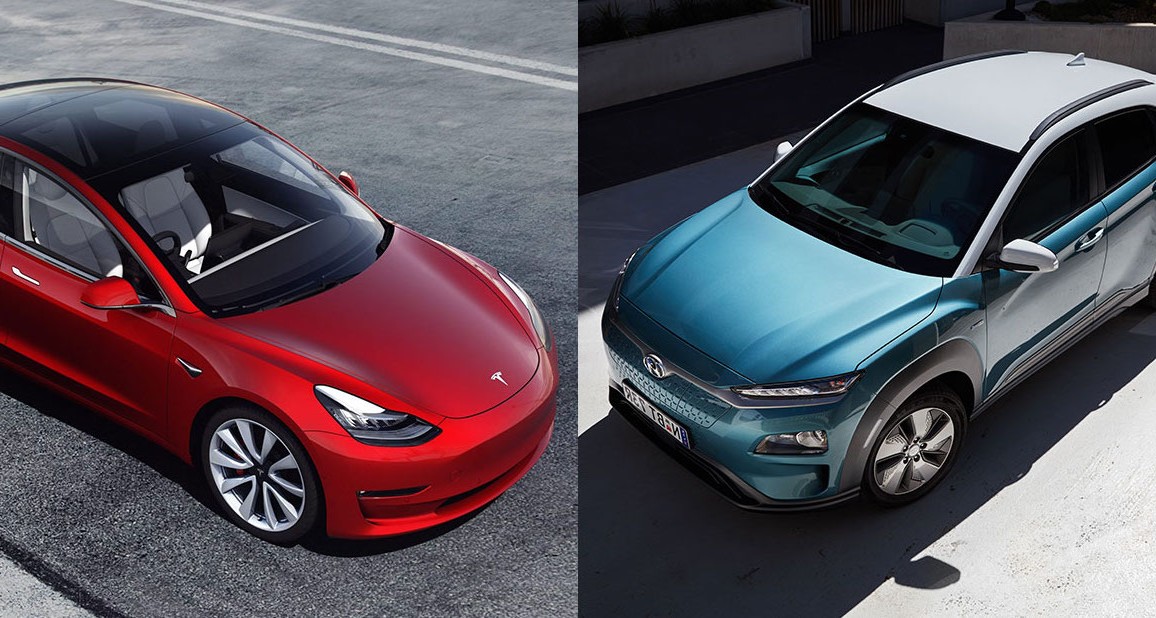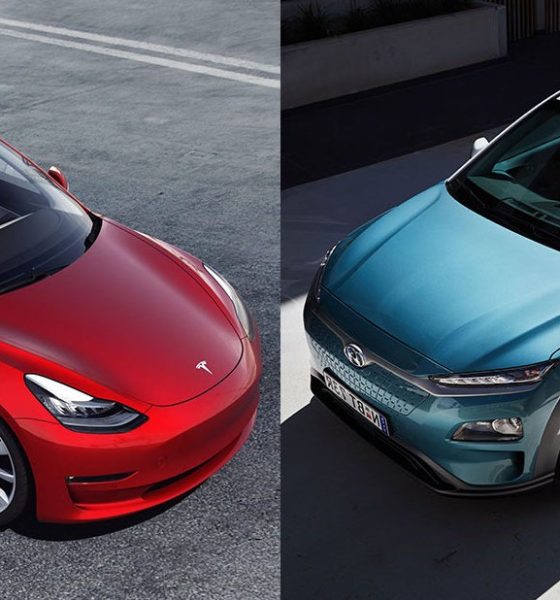

News
Tesla’s rise in South Korea pushes Hyundai to focus on EVs instead of hydrogen
In a 2014 book, Hyundai’s then R&D Chief Lee Hyun-soon, who also happens to be the one who developed South Korea’s first gasoline engines, argued that electric vehicles were “not realistic,” and part of this is due to their high battery costs. According to Lee, hydrogen based cars are a better zero emissions alternative, and the technology offered a “bright future.”
Hyundai, together with experienced carmakers such as Toyota and upstart companies like Nikola, bet big on the adoption and spread of hydrogen vehicles. The company launched the Tucson Fuel Cell in 2013 and the NEXO in 2018, both of which garnered a fair amount of optimism. However, this optimism did not translate to sales, and the hydrogen boom that was to come did not come at all.
Last year, 7,707 hydrogen fuel cell cars were sold globally. In comparison, there were 1.68 million electric vehicles that were sold in 2019, more than 86,000 of which came from Hyundai itself, as per figures from LMC Automotive. Tesla, the leader in EVs today, sold a whopping 367,500 vehicles last year, and that’s with a lineup comprised solely of premium cars.
Tesla’s expansion has been felt in South Korea. Since the launch of the Model 3, Tesla has spread its reach into the country. In June alone, Tesla had its best month in South Korea, beating Hyundai’s Kona EV and other premium rivals from BMW and Audi. Last month, South Korea’s rental service firm SK Rent-a-Car even announced that it would be adding the Tesla Model 3 to its fleet, simply because new Tesla products were the “most favored” electric cars among its customers.
In a statement to Reuters, an industry insider stated that Tesla’s rise has caught Hyundai by surprise. “Hyundai did not expect Tesla to dominate the EV market so quickly,” the source said. But with the demand for electric cars being established and highlighted in the country by Tesla’s rise, Hyundai is mobilizing to catch up. An internal union newsletter retrieved by the news outlet, for example, revealed that Hyundai intends to introduce two production lines dedicated to EVs in the near future. The first of these would be introduced as early as next year.
Euisun Chung, the leader of the Hyundai Motor Group conglomerate, has reportedly held a series of meetings with his counterparts at Samsung, LG, and SK Group, companies that manufacture batteries and electronic parts. In a statement to Reuters, Hyundai noted that it was collaborating with South Korean battery suppliers to “scale up” its EV production capabilities to compete in the electric car segment better.
Amidst these strategies, Hyundai has started what appears to be a definitive step away from hydrogen cars to electric vehicles. The company still promotes its hydrogen cars with popular K-pop band BTS, but it only intends to produce two hydrogen vehicles by 2025. In comparison, the company intends to have 23 battery powered cars by then. This was highlighted in a statement last month by Chung, who stated that the company wants to sell 1 million EVs per year, grabbing a global market share of 10%, by 2025.

Elon Musk
Starlink passes 9 million active customers just weeks after hitting 8 million
The milestone highlights the accelerating growth of Starlink, which has now been adding over 20,000 new users per day.

SpaceX’s Starlink satellite internet service has continued its rapid global expansion, surpassing 9 million active customers just weeks after crossing the 8 million mark.
The milestone highlights the accelerating growth of Starlink, which has now been adding over 20,000 new users per day.
9 million customers
In a post on X, SpaceX stated that Starlink now serves over 9 million active users across 155 countries, territories, and markets. The company reached 8 million customers in early November, meaning it added roughly 1 million subscribers in under seven weeks, or about 21,275 new users on average per day.
“Starlink is connecting more than 9M active customers with high-speed internet across 155 countries, territories, and many other markets,” Starlink wrote in a post on its official X account. SpaceX President Gwynne Shotwell also celebrated the milestone on X. “A huge thank you to all of our customers and congrats to the Starlink team for such an incredible product,” she wrote.
That growth rate reflects both rising demand for broadband in underserved regions and Starlink’s expanding satellite constellation, which now includes more than 9,000 low-Earth-orbit satellites designed to deliver high-speed, low-latency internet worldwide.
Starlink’s momentum
Starlink’s momentum has been building up. SpaceX reported 4.6 million Starlink customers in December 2024, followed by 7 million by August 2025, and 8 million customers in November. Independent data also suggests Starlink usage is rising sharply, with Cloudflare reporting that global web traffic from Starlink users more than doubled in 2025, as noted in an Insider report.
Starlink’s momentum is increasingly tied to SpaceX’s broader financial outlook. Elon Musk has said the satellite network is “by far” the company’s largest revenue driver, and reports suggest SpaceX may be positioning itself for an initial public offering as soon as next year, with valuations estimated as high as $1.5 trillion. Musk has also suggested in the past that Starlink could have its own IPO in the future.
News
NVIDIA Director of Robotics: Tesla FSD v14 is the first AI to pass the “Physical Turing Test”
After testing FSD v14, Fan stated that his experience with FSD felt magical at first, but it soon started to feel like a routine.

NVIDIA Director of Robotics Jim Fan has praised Tesla’s Full Self-Driving (Supervised) v14 as the first AI to pass what he described as a “Physical Turing Test.”
After testing FSD v14, Fan stated that his experience with FSD felt magical at first, but it soon started to feel like a routine. And just like smartphones today, removing it now would “actively hurt.”
Jim Fan’s hands-on FSD v14 impressions
Fan, a leading researcher in embodied AI who is currently solving Physical AI at NVIDIA and spearheading the company’s Project GR00T initiative, noted that he actually was late to the Tesla game. He was, however, one of the first to try out FSD v14.
“I was very late to own a Tesla but among the earliest to try out FSD v14. It’s perhaps the first time I experience an AI that passes the Physical Turing Test: after a long day at work, you press a button, lay back, and couldn’t tell if a neural net or a human drove you home,” Fan wrote in a post on X.
Fan added: “Despite knowing exactly how robot learning works, I still find it magical watching the steering wheel turn by itself. First it feels surreal, next it becomes routine. Then, like the smartphone, taking it away actively hurts. This is how humanity gets rewired and glued to god-like technologies.”
The Physical Turing Test
The original Turing Test was conceived by Alan Turing in 1950, and it was aimed at determining if a machine could exhibit behavior that is equivalent to or indistinguishable from a human. By focusing on text-based conversations, the original Turing Test set a high bar for natural language processing and machine learning.
This test has been passed by today’s large language models. However, the capability to converse in a humanlike manner is a completely different challenge from performing real-world problem-solving or physical interactions. Thus, Fan introduced the Physical Turing Test, which challenges AI systems to demonstrate intelligence through physical actions.
Based on Fan’s comments, Tesla has demonstrated these intelligent physical actions with FSD v14. Elon Musk agreed with the NVIDIA executive, stating in a post on X that with FSD v14, “you can sense the sentience maturing.” Musk also praised Tesla AI, calling it the best “real-world AI” today.
News
Tesla AI team burns the Christmas midnight oil by releasing FSD v14.2.2.1
The update was released just a day after FSD v14.2.2 started rolling out to customers.

Tesla is burning the midnight oil this Christmas, with the Tesla AI team quietly rolling out Full Self-Driving (Supervised) v14.2.2.1 just a day after FSD v14.2.2 started rolling out to customers.
Tesla owner shares insights on FSD v14.2.2.1
Longtime Tesla owner and FSD tester @BLKMDL3 shared some insights following several drives with FSD v14.2.2.1 in rainy Los Angeles conditions with standing water and faded lane lines. He reported zero steering hesitation or stutter, confident lane changes, and maneuvers executed with precision that evoked the performance of Tesla’s driverless Robotaxis in Austin.
Parking performance impressed, with most spots nailed perfectly, including tight, sharp turns, in single attempts without shaky steering. One minor offset happened only due to another vehicle that was parked over the line, which FSD accommodated by a few extra inches. In rain that typically erases road markings, FSD visualized lanes and turn lines better than humans, positioning itself flawlessly when entering new streets as well.
“Took it up a dark, wet, and twisty canyon road up and down the hill tonight and it went very well as to be expected. Stayed centered in the lane, kept speed well and gives a confidence inspiring steering feel where it handles these curvy roads better than the majority of human drivers,” the Tesla owner wrote in a post on X.
Tesla’s FSD v14.2.2 update
Just a day before FSD v14.2.2.1’s release, Tesla rolled out FSD v14.2.2, which was focused on smoother real-world performance, better obstacle awareness, and precise end-of-trip routing. According to the update’s release notes, FSD v14.2.2 upgrades the vision encoder neural network with higher resolution features, enhancing detection of emergency vehicles, road obstacles, and human gestures.
New Arrival Options also allowed users to select preferred drop-off styles, such as Parking Lot, Street, Driveway, Parking Garage, or Curbside, with the navigation pin automatically adjusting to the ideal spot. Other refinements include pulling over for emergency vehicles, real-time vision-based detours for blocked roads, improved gate and debris handling, and Speed Profiles for customized driving styles.








